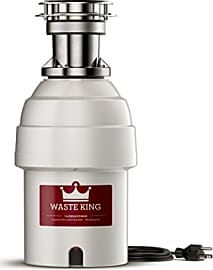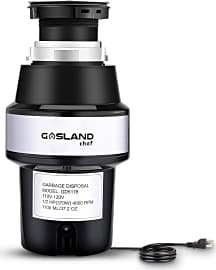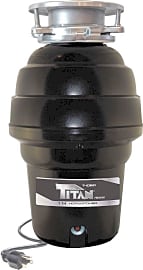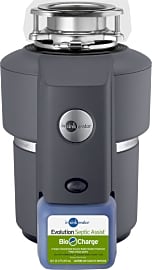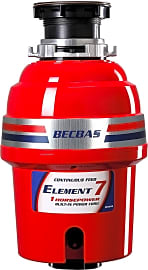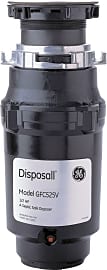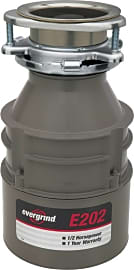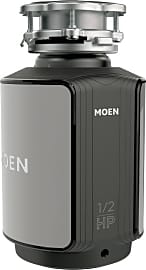The 10 Best Garbage Disposals

This wiki has been updated 43 times since it was first published in March of 2015. From costly sink clogs to potential methane buildup in the local landfill, food waste can be a big problem. The solution? Getting the best garbage disposal possible. Our selection includes a variety of models ranked with attention to expense, noise, capacity, power, and warranty. The choices range from quick and easy installations to quiet monsters ready to clean up after a big dinner party. When users buy our independently chosen editorial choices, we may earn commissions to help fund the Wiki.
Editor's Notes
March 31, 2021:
A garbage disposal unit mounts to the underside of a kitchen sink via the drain, and is designed to collect solid food waste in a grinding chamber. Once activated, a spinning disk, or set of blades, shred the solids into tiny pieces that can be washed away without blocking the pipes. The power and RPM of the motor and the size of the grinding chamber are the main factors that influence how effectively the unit performs and this is obviously reflected in the price.
In this update, we switched several models with their most up-to-date counterparts. Waste King and InSinkErator are two highly recommended companies in the waste disposal industry, and in this ranking, we included the Waste King 9980TC, which, although being one of the pricier models, has a one-horsepower motor that generates 2,800 RPM and features all stainless steel grinding components. This along with its sound-insulated housing make it a good choice for daily use and larger families. The InSinkErator 74032 and the InSinkErator Evolution Excel are two high-quality options, the former of which features a bio-friendly additive that helps break down food, thus making it ideal for use with septic tank systems. The latter boasts a three-stage grinding process that can handle the toughest food scraps, including fruit rinds and chicken bones. As a budget option, we included the Gasland Chef, a lightweight unit with an ABS plastic shell that boasts a 4000 rpm high-speed motor and a bladeless grinding system. However, its 1/2-horsepower motor may be slightly underpowered for some fibrous vegetables and peels.
February 16, 2020:
Despite the power it offered, the Waste King 5000 was replaced with a new lineup of disposals from the company, one of which is the upgrade to their 9940, the new 9980TC, which cuts through food in batches and places its reset button on the front of the body, rather than on the underside, so it's much easier to get to if the motor gets overloaded.
We also added the Titan 10-US Premium 1060 to our ranking, as this is a model whose 1-1/4 HP motor outperforms the vast majority of the rest of the market, and whose odor-fighting treatment is among the best in the business. A poorly made sink flange is the only thing keeping it from a higher spot on the list.
Our other addition was the West Maid Premium, the balanced impellers in which make for a significantly low-vibration performance, which is ideal for anyone who uses their disposal several times a day, as it's liable to stand the test of time. Beyond those considerations, we ordered our ranking based on horsepower, motor performance, compatibility with septic systems, and the ins and outs of a given assembly and installation process.
Special Honors
Drain Treatment Even the best garbage disposal unit will require regular cleaning to maintain performance and prevent odors. Bio-wonder is an all-natural blend of friendly bacteria and enzymes that eliminate waste buildup and decompose the materials that clog pipes and drains. bio-wonder.com
Mr Rooter With locations throughout the USA, Mr Rooter can handle all aspects of waste disposal installations and maintenance and have detailed knowledge of nearly all makes and models of garbage disposals. Call them to speak to a professional, or request an estimate online via their website. mrrooter.com
Responsibly Out Of Sight And Out Of Mind
When food is kept cold and hard, it is less likely to cause a blockage in the sink's drain system while the disposal is running.
When you have a big family, are busy in the kitchen cooking elaborate meals for everyday consumption or special occasions, or you have food that is no longer edible and requires tossing, kitchen waste is inevitable. For that reason, you'll need a reliable garbage disposal for your sink to grind food waste into pieces small enough to pass through your plumbing system without having to store them in a trash compactor until garbage night.
A garbage disposal is an electrically-powered device typically installed under a kitchen sink. It is usually located between the drain and sink trap and designed to chew up food scraps in combination with a heavy flow of cold water. Cold water helps to congeal and solidify certain foods that would otherwise have a tendency to be slippery or sticky at higher temperatures. When food is kept cold and hard, it is less likely to cause a blockage in the sink's drain system while the disposal is running.
A disposal has several parts working together to grind up foods, including an upper hopper, shredder ring, a flywheel equipped with impellers, a lower hopper, electric motor, and a waste line connector. Let's use a piece of aged celery as our food guinea pig to describe how the device works. When you start the disposal, its motor activates in order to power and spin the flywheel at nearly 2,000 revolutions per minute. When the celery enters the drain, it falls through the disposal's upper hopper chamber and onto the spinning flywheel. The flywheel's impellers serve to fling the garbage against the disposal's shredder ring, which chops up the celery as it rotates around the flywheel. Once the food has been chopped up, the cold water from the sink flushes the pulverized waste down into the lower hopper where it finally exits through the waste line connector and into the pipes. In order for this process to work as efficiently as possible, most garbage disposal units are rated to at least one-half horsepower, but a range of three-quarters to one horsepower is strongly recommended for the best results.
Garbage disposals are available in either batch feed or continuous designs. Batch feed units are activated using specially-designed covers placed over their openings. They are designed to operate after food waste has been placed inside them. The covers for batch feed units are equipped with magnets and are twisted to align with additional magnets inside the disposal units themselves. By contrast, continuous feed disposals are more common than batch feed units and are activated with an electric switch before waste is placed inside them. They will continue to operate until the power has been cut.
Batch feed units tend to be quieter and a bit safer to use than continuous feed models due to the use of their covers, which serve to muffle the sound of their motors, while also protecting a person's hands from venturing too far down into the disposal's opening. Continuous models also have a tendency to burn out if the power is left on for too long, whereas batch feed units will only activate through the use of magnetic cover. However, use of a cover can also be problematic, as it's another piece required for the disposal to function in the first place. Most modern garbage disposals feature built-in overload protection designed to cut power to the units before their motors overheat and cause damage the devices.
Disposal Units Of Choice
The best disposals have stainless steel components and powerful motors up to one horsepower. Power is one of the most important considerations to ensure that your food is properly chopped up in order to prevent frequent drain clogs. Having the power to grind food waste into pieces as small as possible is essential for your drainage system and it's especially important if you live in a home that uses a septic system.
This button can usually be pushed back in to restore power to the unit.
If you plan to invest in a continuous feed disposal, make sure the unit has sufficient overload protection. Disposals with this feature will have a reset button underneath their lower hopper chambers designed to pop out when the power is cut. This button can usually be pushed back in to restore power to the unit.
A disposal with auto-reverse functionality will also come in very handy should it become jammed, which you know is bound to happen at least once or twice during its lifetime. Many modern units are equipped with a flywheel-turning wrench hole on their undersides, which can be accessed to manually clear a jam. Finally, if you and your family are sensitive to noise, try to find a model with sound-reduction functionality to keep the motor operating as quietly as possible.
A Brief History Of The Garbage Disposal
The very first garbage disposal was invented by architect John W. Hammes of Racine, Wisconsin in 1927 out of a need to make cleaning up the kitchen easier for his wife. The patent for the device was filed in 1933 and later granted to Hammes in 1935. Shortly thereafter, Hammes founded the InSinkErator company in 1940 to manufacture and sell his design. This brand name is still well-known today.
Throughout many cities in the United States during the 1940s (New York City especially), the municipal sewage system maintained regulations against having food waste put into it, even labeling such devices as illegal. However, Hammes' company put forth a significant amount of effort to have these regulations rescinded.
Popularity of garbage disposals has remained at its strongest in the United States, as nearly 50 percent of homes were equipped with the units as of 2009, compared to only a small fraction of that percentage in the United Kingdom.



